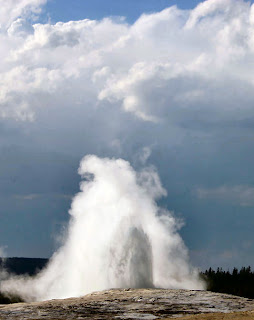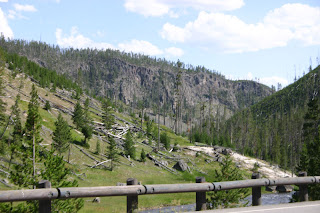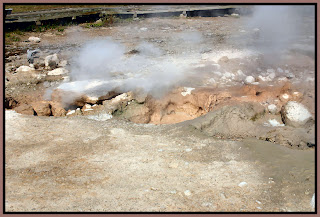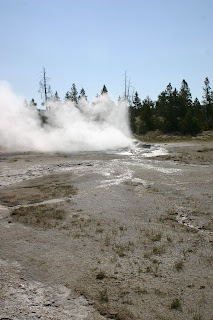
The experience of Old Faithful, as the most popular geyser in the world is a thrill to say the least. This says nothing about all the hundreds of other geysers and hot springs in the park. When we viewed the Old Faithful eruption, we had the additional excitement of having a thunder storm and rain shower at almost the exact same time that the geyser erupted. This added excitement was not there the next day when we calmly sat around waiting to watch it all over again (sans rain gear).
Our guide told us that Old Faithful, is not the largest, or the most consistent or even regular of the geysers in the park. But he did say it is the most watched and photographed geyser in the park. The infamous Old Faithful geyser got its name because of its punctuality and predictability. Old Faithful erupts more frequently than other large geysers. We did get to see another one (which I can’t remember its name) but it only goes off every 2-3 days and sometimes doesn’t go off for a week or so. So it is not something that people are willing to wait around for. (Well at least MOST people!)
At the time we were in the park, Old Faithful was erupting about every 91 minutes. But they say to give it 10 minutes on both sides of its projected eruption time. The guide also said Old Faithful is the most popular attraction of Yellowstone National Park. As I mentioned, although it is the most photographed and most talked about, Old Faithful is not the largest or most grand geyser. The Upper Geyser Basin, Black Sand and Biscuit Basin offer much more sights to see than just the Old Faithful geyser.
Some interesting facts about Old Faithful that dispel many myths about the geyser are that its eruption length and height, and time between eruptions varies from day to day and year to year. As of March 2003, the eruption length ranges from 1.5 to 5 minutes; the average interval between eruptions is 94 minutes. Old Faithful's height ranges from 106 feet to more than 180 feet, averaging 130 feet. Its average eruption length, height and interval will change again--often as a result of an earthquake. 3,700 to 8,400 gallons of water are expelled per eruption, depending on the length of eruption. Just prior to eruption, water temperature at the vent is 204° F / 95.6° C. It's just one of the more than 300 geysers in Yellowstone.
Old Faithful is a cone geyser, which erupts in a narrow jet of water, usually from a cone. Fountain geysers, such as Grand (also in the Upper Geyser Basin), generally shoot water in various directions, most often from a pool. (I’d hazard a guess that those were pool geysers?)
To truly experience all that this Old Faithful area has to offer, you will have to walk around a bit in the surrounding area. There are wooden paths everywhere to keep you out of trouble and out of the geysers. These paths are like old Atlantic City boardwalks and you can even see steam coming up right along many of these areas. The geyser basin area kind of gave you an eerie feeling of walking around on the moon or some warmer planet somewhere else in our universe must be like.
Over time, the average interval between Old Faithful's eruptions increases, in part due to ongoing processes within its plumbing. Changes also result from earthquakes. Prior to the 1959 Hebgen Lake Earthquake, centered 12 miles northwest of the park's west entrance, the interval between Old Faithful's eruptions averaged slightly more than one hour. Its intervals increased after that earthquake and again after the 1983 Borah Peak Earthquake, centered in Idaho. In 1998, an earthquake near Old Faithful lengthened the interval again; later, another swarm of earthquakes further increased intervals.
Between long intervals and other variable, waiting for Old Faithful's eruptions can stretch beyond the predicted time. Think of it this way: you've got time now to meet other visitors, enjoy many other Upper Geyser Basin's geysers and thermal features, or read about the park, or take a much needed rest. So relax, be flexible, and enjoy the time you spend with the world's most famous geyser; and that is exactly what we did! What a place!
I've also added some sequential shots of what it looks like as it starts sputtering and then fully goes up to its maximum of about 150 feet when we saw it both times (with and without the rain shower). It is really quiet beautiful!
"To love another person is to see the face of God." ~ Les Miserables (the musical)



 Well… before actually leaving the Park and making the trek south toward Teton National Park, I just wanted a chance to post some of my favorite photos I shot here in this “living and breathing” park.
Well… before actually leaving the Park and making the trek south toward Teton National Park, I just wanted a chance to post some of my favorite photos I shot here in this “living and breathing” park. 

































